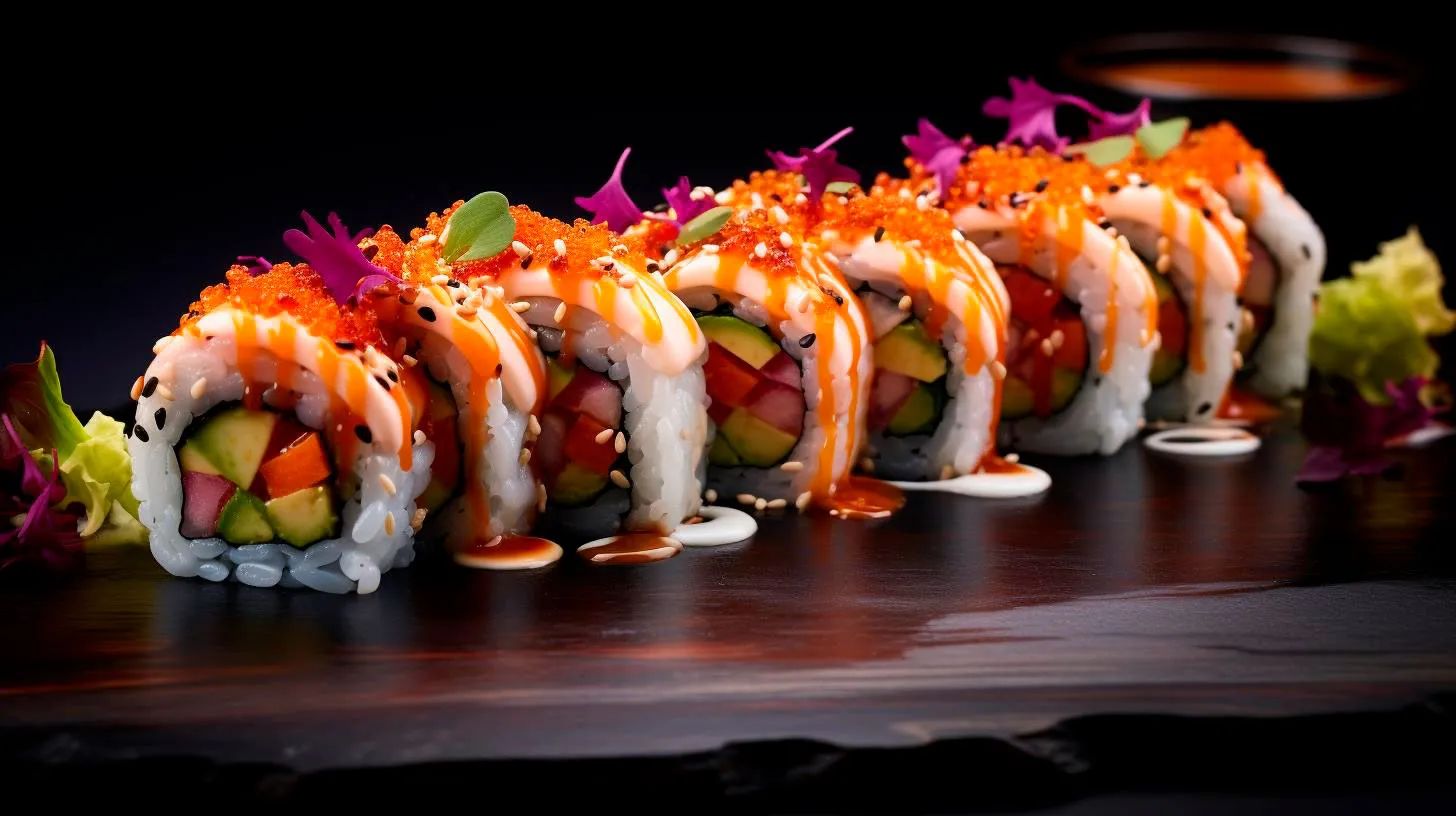Mastering the art of sushi rolling techniques
In this article, we will take you through the step-by-step process of creating sushi rolls that are visually appealing and bursting with flavors.
Why mastering sushi rolling techniques is important?
Rolling sushi requires precision and technique. It is the skillful combination of ingredients, rolling, and cutting that creates a sushi roll masterpiece. When you master sushi rolling techniques, you can elevate your sushi-making game and impress your friends and family with your culinary skills. Here are a few key reasons why mastering sushi rolling techniques is important:
- Visual appeal: Mastering sushi rolling techniques allows you to create visually stunning rolls that are pleasing to the eye. The artistry of sushi rolling is just as important as its taste, and perfectly rolled sushi will always impress.
- Consistency: With proper techniques, you can achieve consistent results every time you make sushi. This ensures that your rolls are evenly shaped and well-packed, allowing for a delightful dining experience.
- Creative possibilities: Learning different sushi rolling techniques opens up a world of creative possibilities. You can experiment with various flavors, fillings, and presentations to create unique sushi creations that reflect your personal style.
Step-by-step guide to mastering sushi rolling techniques
1. Prepare your ingredients and tools
Before you start rolling sushi, you need to gather all the necessary ingredients and tools. Here’s what you’ll need:
- Fresh sushi-grade fish or other fillings of your choice
- Sushi rice – short-grain rice seasoned with vinegar
- Nori seaweed sheets
- A bamboo sushi mat (makisu) covered with plastic wrap
- A sharp knife for cutting the sushi rolls
2. Master the perfect sushi rice
Sushi rice is the foundation of any good sushi roll. Achieving the perfect texture and flavor is crucial. Follow these steps to master sushi rice:
- Rinse the rice in cold water until the water becomes clear, then cook it according to the package instructions.
- Once cooked, transfer the rice to a wooden bowl and gently fold in seasoned rice vinegar using a wooden spatula. Allow it to cool to room temperature while fanning it to remove excess moisture.
3. Prepare the sushi roll fillings
The fillings are where you can get creative with your sushi rolls. Choose from a variety of options such as fresh fish, avocado, cucumber, carrots, or even cooked ingredients like tempura. Cut your fillings into long, thin strips for easier rolling.
4. Rolling techniques
Now comes the fun part – rolling the sushi! Follow these steps for a perfect sushi roll:
- Place a sheet of nori on top of the plastic-wrapped bamboo mat.
- Dip your hands in water to prevent the rice from sticking, then grab a handful of sushi rice and evenly spread it on the nori, leaving approximately one inch at the top uncovered.
- Place your desired fillings in the center of the rice.
- Begin rolling the sushi using the bamboo mat, gently applying pressure to form a tight roll. Wetting the uncovered nori edge will help seal the roll.
- Once rolled, use a sharp knife dipped in water to cut the sushi roll into bite-sized pieces.
5. Presentation and garnishing
A visually appealing presentation can enhance the overall sushi experience. Consider garnishing your sushi rolls with ingredients like sesame seeds, microgreens, or colorful sauces. Let your creativity shine through!
Key takeaways
Mastering sushi rolling techniques takes time and practice, but the results are well worth the effort. Here are the key takeaways:
- Visual appeal is crucial when rolling sushi.
- Consistency can be achieved through proper techniques.
- Sushi rolling opens up a world of creative possibilities.
- Prepare your ingredients and tools before rolling.
- Master the art of sushi rice preparation.
- Get creative with your sushi roll fillings.
- Follow the step-by-step rolling techniques for perfect rolls.
- Presentation and garnishing can enhance the sushi experience.
So, roll up your sleeves, gather your ingredients, and start mastering the art of sushi rolling techniques. With time and practice, you’ll be rolling sushi like a pro and impressing everyone with your beautifully crafted and delicious rolls.
Enhancing Your Sushi with Authentic Japanese Ingredients
In this article, we will explore the benefits of using authentic Japanese ingredients and how they can enhance your sushi creations.
Why Choose Authentic Japanese Ingredients?
Authentic Japanese ingredients bring a unique charm and depth to your sushi. Here are a few compelling reasons why you should consider incorporating them into your sushi-making process:
- Superior Quality: Japanese ingredients are renowned for their high quality, as they are often produced and sourced using traditional and meticulous methods. This ensures that each ingredient has a distinct flavor and texture, adding complexity to your sushi.
- Traditional Techniques: Japanese culinary traditions that have been passed down through generations play a vital role in the production of authentic ingredients. These techniques emphasize freshness, purity, and balance, enhancing both the taste and aesthetics of your sushi.
- Authentic Flavors: Japanese ingredients offer a wide range of unique flavors that cannot be replicated easily. From the subtle umami of miso paste to the delicate sweetness of mirin, each ingredient contributes to an authentic taste experience.
- Cultural Significance: Incorporating authentic Japanese ingredients respects the cultural roots of sushi. It allows you to honor and celebrate the traditions behind this beloved dish while also creating an exciting fusion of flavors.
Key Authentic Japanese Ingredients for Sushi
There are numerous authentic Japanese ingredients that can elevate your sushi game. Here are a few must-have ingredients:
1. Nori:
Nori, or dried seaweed, is an essential ingredient for sushi. It adds a savory and slightly briny flavor while providing a satisfying crunch. Look for high-quality nori sheets for the best results.
2. Wasabi:
True wasabi, derived from the wasabi plant, offers a distinct and fresh spiciness that elevates the flavor profile of your sushi. It complements the fish and adds a pleasant kick to each bite.
3. Mirin:
Mirin, a sweet rice wine, adds a subtle sweetness to your sushi rice, enhancing its overall flavor. It also helps to give the rice a glossy appearance, making your sushi look even more appetizing.
4. Tamari or Soy Sauce:
Tamari, a gluten-free alternative to traditional soy sauce, provides a rich and full-bodied taste. It’s the perfect dipping sauce for your sushi and can also be used as a seasoning to amplify the umami flavors.
5. Pickled Ginger (Gari):
Gari, pickled ginger, serves as a palate cleanser between sushi bites. Its tangy and refreshing flavor helps to cleanse the palate, allowing you to fully enjoy the flavors of different sushi varieties.
6. Sesame Seeds:
Sesame seeds, both black and white, are often sprinkled on top of sushi rolls. They add a delightful nutty flavor, contrasting texture, and visual appeal to your sushi creations.
Enhance Your Sushi Experience
By using authentic Japanese ingredients, you can take your sushi creations to new heights. Here are some key takeaways to enhance your sushi experience:
- Invest in high-quality, authentic Japanese ingredients to ensure superior taste and quality.
- Experiment with different flavors and textures by incorporating a variety of authentic Japanese ingredients.
- Learn about the cultural significance behind each ingredient and embrace the traditions associated with sushi.
- Use relevant industry statistics to highlight the popularity and growth of sushi both domestically and internationally.
- Stay updated with the latest sushi trends and explore innovative ways to incorporate authentic Japanese ingredients into your sushi recipes.
Remember, sushi is not just a meal—it’s an artistic experience that tantalizes the senses. By using authentic Japanese ingredients, you can embark on a culinary journey that celebrates the rich traditions and flavors of Japan.
Selecting the Perfect Rice for Sushi
In this article, we will guide you through the process of selecting the perfect rice for sushi and provide you with essential tips to enhance your sushi-making skills.
Understanding the Importance of Rice in Sushi
Rice is the fundamental ingredient in sushi. It acts as the canvas to showcase the flavors of the fish, vegetables, and other toppings. The sticky nature of sushi rice helps to hold the ingredients together and adds a pleasant mouthfeel. Therefore, selecting the right type of rice is crucial to achieving the desired taste, texture, and appearance of your sushi.
When it comes to sushi rice, the two main varieties are short-grain Japanese rice and medium-grain California rice. The short-grain Japanese rice is the traditional choice for sushi, while medium-grain California rice is a popular alternative due to its availability. Both types of rice can produce excellent sushi, but it ultimately depends on your personal preference and the accessibility of these varieties in your area.
Characteristics of the Perfect Sushi Rice
To identify the perfect sushi rice, here are some key characteristics to consider:
- Stickiness: Sushi rice should be sticky enough to hold its shape when rolled into sushi rolls or formed into nigiri. The stickiness allows for easy handling and ensures the ingredients stay intact.
- Glossiness: The grains of sushi rice should have a glossy sheen to them. This visual appeal adds to the overall presentation of your sushi dish.
- Sweetness: Sushi rice should have a subtle sweetness that complements the flavors of the other ingredients. This balance is essential to creating a harmonious sushi flavor profile.
- Texture: The ideal sushi rice has a tender and slightly chewy texture. The grains should be soft, yet firm enough to hold their shape without becoming mushy.
Selecting the Right Rice Grain Size
The grain size of sushi rice can vary, and it also affects the final result of your sushi. Here are the two primary grain sizes to consider:
Short-Grain Japanese Rice:
Short-grain Japanese rice, also known as Japonica rice, is the traditional choice for sushi. It has a short and plump grain, which becomes sticky when cooked. Short-grain rice is highly starchy and releases a moderate amount of moisture, contributing to the desired stickiness of sushi rice. This rice variety is widely available in Asian markets and online stores, making it accessible for sushi enthusiasts worldwide.
Medium-Grain California Rice:
Medium-grain California rice is a suitable alternative for sushi rice, especially if short-grain Japanese rice is not readily available in your area. California-grown rice has a slightly longer and less sticky grain compared to Japanese rice. However, it still offers enough stickiness to create decent sushi. The advantage of using medium-grain rice is that it tends to be less expensive and more widely available in regular grocery stores.
Key Takeaways
To summarize, here are the key takeaways when selecting the perfect rice for sushi:
- Select either short-grain Japanese rice or medium-grain California rice, depending on availability and personal preference.
- Ensure the rice is sticky, glossy, slightly sweet, and has a desirable texture.
- Consider grain size, with short-grain Japanese rice being the traditional choice and medium-grain California rice serving as a suitable alternative.
By selecting the right rice for your sushi, you can elevate the overall sushi experience and impress your guests with authentic flavors and textures. Experiment with different rice varieties, and remember to have fun in the process. Happy sushi-making!
Choosing the Freshest Fish and Seafood: Unleashing Flavor from the Ocean
Join us on this journey as we unlock the secrets to unleashing the full flavor potential of these aquatic delights.
The Importance of Freshness
When it comes to fish and seafood, freshness is key. Opting for the freshest catch ensures optimal taste, texture, and nutritional value. Nobody likes lackluster, rubbery seafood, right? Following a few simple guidelines can make all the difference in your culinary adventures.
Know Your Seafood Market
Before heading to the fish market or grocery store, do a quick online search to find the most reputable seafood vendors in your area. Look for establishments that prioritize quality, sustainability, and freshness. Shopping at a reliable seafood market will significantly increase your chances of finding the freshest and most flavorful fish available.
The Five Senses of Freshness
While at the market or store, engage your five senses to determine the freshness of the fish:
- Appearance: Choose fish with bright, clear eyes, shiny skin, and vibrant colors. Avoid any discoloration, dullness or signs of dehydration.
- Aroma: Fresh fish should have a pleasant, seawater scent. Avoid any fish with a strong, ammonia-like smell, as it may indicate spoilage.
- Texture: Gently press the fish to check for firmness. Fresh fish should spring back when touched and leave no indents.
- Gills: If buying whole fish, examine the gills. They should be brightly colored, moist, and free of slime.
- Impressions: Fresh fish should not leave any sticky residue on your hands or the packaging. It should be clean and properly handled.
Keeping an Eye on Seasonality
Stay informed about which fish are in season throughout the year. Choosing fish when they are in peak season ensures optimal freshness, as well as better pricing. Additionally, seasonal fish are often sourced locally, reducing their carbon footprint while supporting the local fishing industry.
The Benefits of Opting for Fresh Fish
Now that you’re armed with the knowledge to choose the freshest fish and seafood, let’s explore the benefits you’ll enjoy when opting for the best of the ocean:
- Enhanced Flavor: Fresh fish delivers a burst of flavor that is superior to its frozen or less fresh counterparts.
- Improved Nutrition: The fresher the fish, the higher the nutritional value. Omega-3 fatty acids, vitamins, and minerals are preserved better in fresh fish.
- Texture and Appearance: Fresh fish retains its natural texture and appearance, making for an appealing and delightful dining experience.
- Sustainable Practices: Choosing fresh, locally-sourced fish encourages sustainable fishing practices and helps preserve marine ecosystems.
- Supporting Local Businesses: Opting for fish in season helps support local fishermen and sustain coastal communities.
Key Takeaways
Remember these key points when selecting fish and seafood:
- Research and choose reputable seafood vendors for the best quality.
- Engage your senses to evaluate the freshness of fish: appearance, aroma, texture, gills, and impressions.
- Keep yourself informed about seasonal fish to optimize freshness and pricing.
- Enjoy the benefits of fresh fish: enhanced flavor, improved nutrition, appealing texture, and support for sustainable fishing practices.
So, next time you’re on the hunt for the freshest fish and seafood, put these tips into practice and reap the rewards. With your newfound knowledge, your taste buds will thank you, and your culinary creations will reach new heights!



